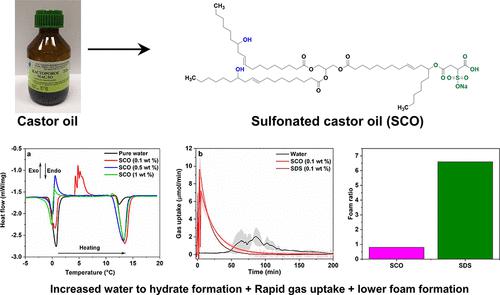当前位置:
X-MOL 学术
›
ACS Sustain. Chem. Eng.
›
论文详情
Our official English website, www.x-mol.net, welcomes your feedback! (Note: you will need to create a separate account there.)
Sulfonated Castor Oil as an Efficient Biosurfactant for Improving Methane Storage in Clathrate Hydrates
ACS Sustainable Chemistry & Engineering ( IF 7.1 ) Pub Date : 2022-07-21 , DOI: 10.1021/acssuschemeng.2c02329 Abdolreza Farhadian 1, 2 , Andrey S. Stoporev 1, 3, 4, 5 , Mikhail A. Varfolomeev 1 , Yulia F. Zaripova 3 , Vladimir V. Yarkovoi 3 , Matvei E. Semenov 1, 6 , Airat G. Kiiamov 7 , Roman S. Pavelyev 1 , Aleksandr M. Aimaletdinov 8 , Tharaa Mohammad 9 , Danis K. Nurgaliev 10
ACS Sustainable Chemistry & Engineering ( IF 7.1 ) Pub Date : 2022-07-21 , DOI: 10.1021/acssuschemeng.2c02329 Abdolreza Farhadian 1, 2 , Andrey S. Stoporev 1, 3, 4, 5 , Mikhail A. Varfolomeev 1 , Yulia F. Zaripova 3 , Vladimir V. Yarkovoi 3 , Matvei E. Semenov 1, 6 , Airat G. Kiiamov 7 , Roman S. Pavelyev 1 , Aleksandr M. Aimaletdinov 8 , Tharaa Mohammad 9 , Danis K. Nurgaliev 10
Affiliation

|
High toxicity and huge foaming are two severe challenges for gas storage strategies based on promoting the gas hydrate formation using surfactants. The present study used castor oil as an eco-friendly resource to develop novel biosurfactants for methane storage. Transmission and scanning electron microscopy, dynamic light scattering, and interfacial tension measurements revealed the surfactant properties of sulfonated castor oil (SCO). In addition, a high-pressure autoclave and a microdifferential scanning calorimeter test unveiled SCO as an effective kinetic hydrate promoter. The results showed that SCO significantly enhanced the rate of methane hydrate formation. A maximum of 76% water-to-hydrate conversion was observed in 0.1 wt % SCO solution under stirring conditions. Pure water, 0.1 wt % SCO, and 0.1 wt % sodium dodecyl sulfate (SDS) solutions allowed 50% conversion to be achieved for 329, 39, and 27 min, respectively. This made the castor oil-based reagent as effective as the well-known kinetic hydrate promoter SDS. Furthermore, the SCO solution’s foam ratio and stability were 8.25 and 2.75 times lower than those of SDS. Additionally, SCO showed a more favorable safety profile for humans and the environment as it is toxic to animals in higher concentrations than SDS according to in vivo studies. In addition, a combination of high-pressure DSC, low-temperature powder X-ray diffractometry, and visual analysis of hydrate samples depending on the temperature mode, promoter type, and its concentration revealed that SCO and SDS enhanced hydrate growth by different mechanisms. The loose hydrate mass was squeezed out toward the gas phase in both cases. However, in the case of SDS, the hydrate traditionally climbed the cell walls while SCO seemed to change the wall wettability, which led to the transfer of water into the reaction zone along with the forming hydrate crystals and the domed shape of the hydrate. These findings provide reliable evidence to synthesize efficient and environmentally friendly reagents based on castor oil to improve methane storage in the clathrate hydrate.
中文翻译:

磺化蓖麻油作为一种有效的生物表面活性剂用于改善笼形水合物中的甲烷储存
高毒性和巨大的泡沫是基于使用表面活性剂促进天然气水合物形成的储气策略的两大严峻挑战。本研究使用蓖麻油作为一种环保资源来开发用于甲烷储存的新型生物表面活性剂。透射和扫描电子显微镜、动态光散射和界面张力测量揭示了磺化蓖麻油 (SCO) 的表面活性剂特性。此外,高压釜和微差扫描量热仪测试揭示了 SCO 作为一种有效的动力学水合物促进剂。结果表明,SCO显着提高了甲烷水合物的形成速率。在搅拌条件下,在 0.1 wt% SCO 溶液中观察到最大 76% 的水水合物转化率。纯水、0.1 wt% SCO 和 0。1 wt% 的十二烷基硫酸钠 (SDS) 溶液分别允许在 329、39 和 27 分钟内实现 50% 的转化。这使得基于蓖麻油的试剂与众所周知的动力学水合物促进剂 SDS 一样有效。此外,SCO 溶液的泡沫比和稳定性分别比 SDS 低 8.25 和 2.75 倍。此外,SCO 对人类和环境显示出更有利的安全性,因为它对动物的毒性高于 SDS,根据体内研究。此外,结合高压 DSC、低温粉末 X 射线衍射和根据温度模式、促进剂类型及其浓度对水合物样品进行目视分析表明,SCO 和 SDS 通过不同的机制促进水合物生长。在这两种情况下,松散的水合物质量都被挤向气相。然而,在 SDS 的情况下,水合物通常会爬上细胞壁,而 SCO 似乎会改变细胞壁的润湿性,这导致水随着水合物晶体的形成和水合物的圆顶形状转移到反应区。这些发现为合成基于蓖麻油的高效环保试剂以改善笼形水合物中的甲烷储存提供了可靠的证据。
更新日期:2022-07-21
中文翻译:

磺化蓖麻油作为一种有效的生物表面活性剂用于改善笼形水合物中的甲烷储存
高毒性和巨大的泡沫是基于使用表面活性剂促进天然气水合物形成的储气策略的两大严峻挑战。本研究使用蓖麻油作为一种环保资源来开发用于甲烷储存的新型生物表面活性剂。透射和扫描电子显微镜、动态光散射和界面张力测量揭示了磺化蓖麻油 (SCO) 的表面活性剂特性。此外,高压釜和微差扫描量热仪测试揭示了 SCO 作为一种有效的动力学水合物促进剂。结果表明,SCO显着提高了甲烷水合物的形成速率。在搅拌条件下,在 0.1 wt% SCO 溶液中观察到最大 76% 的水水合物转化率。纯水、0.1 wt% SCO 和 0。1 wt% 的十二烷基硫酸钠 (SDS) 溶液分别允许在 329、39 和 27 分钟内实现 50% 的转化。这使得基于蓖麻油的试剂与众所周知的动力学水合物促进剂 SDS 一样有效。此外,SCO 溶液的泡沫比和稳定性分别比 SDS 低 8.25 和 2.75 倍。此外,SCO 对人类和环境显示出更有利的安全性,因为它对动物的毒性高于 SDS,根据体内研究。此外,结合高压 DSC、低温粉末 X 射线衍射和根据温度模式、促进剂类型及其浓度对水合物样品进行目视分析表明,SCO 和 SDS 通过不同的机制促进水合物生长。在这两种情况下,松散的水合物质量都被挤向气相。然而,在 SDS 的情况下,水合物通常会爬上细胞壁,而 SCO 似乎会改变细胞壁的润湿性,这导致水随着水合物晶体的形成和水合物的圆顶形状转移到反应区。这些发现为合成基于蓖麻油的高效环保试剂以改善笼形水合物中的甲烷储存提供了可靠的证据。















































 京公网安备 11010802027423号
京公网安备 11010802027423号